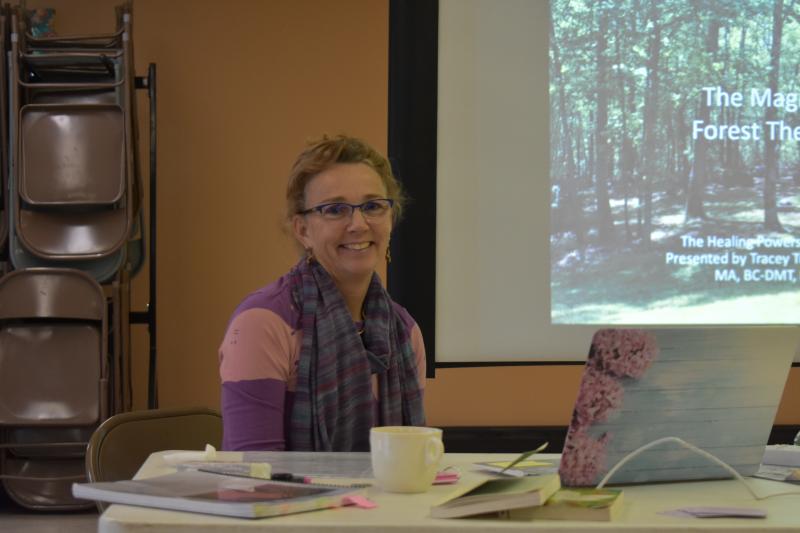“I find that taking someone out into the woods, and just allowing them to let their anger be absorbed through the earth, and allow themselves to reconnect with themselves in nature can probably do as much therapy as two or three weeks of therapy in my office,” said therapist Tracey Turner-Keyser.
Turner-Keyser works with patients dealing with stress, depression, anxiety, and Post Traumatic Stress Disorder. She works with family dynamics and individual concerns in her North Carolina office.
And, now since gaining certification in the heart rate-reducing concept of Forest Bathing – a Japanese creation gaining recognition in the U.S. – Turner-Keyser is uniting her veterans and suicidal teenage boys with the elements of nature.
They go with her easily, she said, during an April meeting of the Owls Head Garden Club (of which her mother is a member). Who doesn’t want to get out of the office and go for a walk?
Whereas people heed the rule of “leave no trace” when visiting the forest, Forest Bathing (or Forest Therapy) holds an different perspective. The therapy is about reciprocal relationship with the environment.
“We are allowing the forest to know that we’ve been there,” she said.
The gift of taking the time to walk under the Cherry Blossoms
Though the Japanese developed the Forest Bathing concept in 1982, they’ve been practicing the concept for many years prior. Their annual cherry blossom festivals have encouraged people to go out of doors for slow wandering through nature.
“The planting of the cherry blossoms in Washington, D.C., oriented in 1912 as a gift of friendship to the people of the United States from the people of Japan,” said Keyser. “The gift offered an opportunity for the U.S. to enjoy the benefits of the plant.
Such ways are to build a fairy house, move a rock, put a hand on a tree and be in communion with that tree.
Trees breath in what humans breath out. In return, people breath in what the trees exhale, according to Turner-Keyser.
In that way, patients leave a trace. They allow themselves to be seen and to be a part of a relationship with the forest.
“It is what makes us feel worthy,” she said. “It makes us remember that we always are, and always will be, lovable. No matter how damaged or how unworthy we feel, we are being seen, being held. We are a part of something.
“A lot of times, when we have a traumatic brain injury – like the warriors, or someone who’s been in a car accident, or someone who has gotten sick – our relationship with our self shifts. That can be very disconcerting, and very scary. It can be very aggravating, and can lead to a lot of anger or fear,” she said.
To walk slowly through a forest, a garden, a hospital path, to prune a potted plant, or sit on a city bench, all while taking moments (2 to 4 hours, if joining an organized forest session) to feel the four elements of nature through the human’s five senses, has now become a recognized therapy technique.
In a guided session, a series of “Invitations” prompts the participant to commune closely with specific aspects of nature – smelling the elderberry, hearing the sounds in each direction, touching the bark. The act of doing so brings people into their present selves, and away from the To-Do lists of their lives. It opens doors and allows communication – because trees communicate with each other already – according to Turner-Keyser – and would communicate with people, if people let them.
“Throughout our exploration, we discover not just the forest, but all of the aspects of ourselves,” she said. “It helps you reconnect. It helps bring your nervous system down to a calmer level. It helps you just feel more at peace.”


























